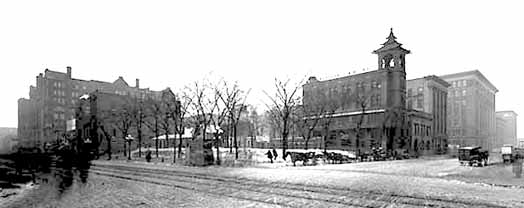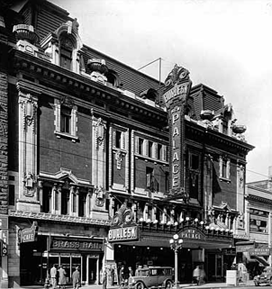Difference between revisions of "Brass Rail Bar"
| (7 intermediate revisions by 3 users not shown) | |||
| Line 1: | Line 1: | ||
<div style="text-align: center;"> | <div style="text-align: center;"> | ||
| − | '''422 Hennepin Avenue, Minneapolis''' | + | '''422 Hennepin Avenue, Minneapolis (1922-1974-2010)''' |
</div> | </div> | ||
| − | 422 Hennepin Avenue is the last building of its kind in the downtown area—the narrow 4-story structure dates to 1901, when citizens referred to its surroundings as “Bridge Square,” so-named for the Hennepin Avenue Bridge. The structure bordered the property of millionaire Levi M. Stewart, an “eccentric recluse”<small>( | + | {{unprotected}} |
| + | 422 Hennepin Avenue is the last building of its kind in the downtown area—the narrow 4-story structure dates to 1901, when citizens referred to its surroundings as “Bridge Square,” so-named for the Hennepin Avenue Bridge.<small>(1)</small> The structure bordered the property of millionaire Levi M. Stewart, an “eccentric recluse”<small>(2)</small> who lived his life as a bachelor in the same house he built in the mid-1800s. Stewart refused to demolish his simple frame dwelling or sell his quarter of the block; the city was forced to grow around it for decades. | ||
<div style="text-align: center;">[[Image:Fourthhenn.jpg]]</div> | <div style="text-align: center;">[[Image:Fourthhenn.jpg]]</div> | ||
<div style="text-align: center;"> | <div style="text-align: center;"> | ||
| − | <small>'''Elder Stewart's residence at Fourth Street and Hennepin Avenue. | + | <small>'''Elder Stewart's residence at Fourth Street and Hennepin Avenue. The Brass Rail Bar boders this park-like property to the left. Image Courtesy of the Minnesota Historical Society'''</small></div> |
| − | |||
| − | Stewart’s land only went to developers after his death in 1910, and two structures soon filled in the site: the future Gay 90s complex and (later) the Palace Theater. The latter structure opened in 1922 as a “Bulesk” house with “Brass Rail Lunch” on the street level.<small>( | + | Stewart’s land only went to developers after his death in 1910, and two structures soon filled in the site: the future Gay 90s complex and (later) the Palace Theater. The latter structure opened in 1922 as a “Bulesk” house with “Brass Rail Lunch” on the street level.<small>(3)</small> The eating establishment’s simple name referred to its bar’s brass fittings—a sign of class and respectability in the Art Deco era. |
| Line 23: | Line 23: | ||
[[Image:Brass_rail.png]] | [[Image:Brass_rail.png]] | ||
</div> <div style="text-align: center;"> | </div> <div style="text-align: center;"> | ||
| − | <small>'''The Brass Rail in the bottom-right (photo bottom-left) corner of the Palace Theater at 414 Hennepin Avenue.'''</small> | + | <small>'''The Brass Rail in the bottom-right (photo bottom-left) corner of the Palace Theater at 414 Hennepin Avenue. Image Courtesy of the Minnesota Historical Society'''</small> |
</div> | </div> | ||
| − | | The Brass Rail moved a few buildings south—to its present location—shortly after the Great Depression. It retained its name despite changes in ownership over the next 40 years.<small>( | + | | The Brass Rail moved a few buildings south—to its present location—shortly after the Great Depression. It retained its name despite changes in ownership over the next 40 years.<small>(4)</small> Interestingly, the hotel upstairs at 422 Hennepin changed names several times, but it was “The Oscar Hotel” for the longest period. |
| − | The first floor became a queer bar in 1974, when a heterosexual couple turned the supper club into the first LGBT piano bar in Minneapolis. The piano added a humorous and unassuming element to the venue; the Brass Rail quickly gained a reputation as “a small bar, friendly, kind of a queer cheers.”<small>( | + | The first floor became a queer bar in 1974, when a heterosexual couple turned the supper club into the first LGBT piano bar in Minneapolis. The piano added a humorous and unassuming element to the venue; the Brass Rail quickly gained a reputation as “a small bar, friendly, kind of a queer cheers.”<small>(5)</small> Drag shows, karaoke, and regulars kept the bar afloat during the 1990s and for most of the 2000s. Financial difficulties threatened the establishment in 2009, but the bar’s future is certain following an extensive renovation. |
|} | |} | ||
| + | |||
| + | ---- | ||
| + | ==This entry is part of:== | ||
| + | == [[Minneapolis/St. Paul, MN: 100 Queer Places in Minnesota History, (1860-2010)]]== | ||
---- | ---- | ||
| − | |||
| − | |||
| − | <small>(3)</small>City of Minneapolis Directories, | + | <small>(1)</small>Millet, Larry. ''Lost Twin Cities.'' St. Paul: Minnesota Historical society Press, 1992. Pages 90-91. |
| + | |||
| + | <small>(2)</small>Worthen, S.C. “Levi M. Stewart: Late Minneapolis Millionaire Not an Eccentric Recluse, as Reported.” The New York Times, May 4th, 1910. | ||
| + | |||
| + | <small>(3)</small>City of Minneapolis Directories, 1920-1940 | ||
| − | <small>(4)</small> | + | <small>(4)</small>City of Minneapolis Directories, 1941-1960 |
| − | + | <small>(5)</small>Matthesen, Elise. “Bright Lights, Bar Nights.” Gaze Magazine, Issue 217: May 27, 1994. Page 35. | |
Latest revision as of 01:56, 20 January 2012
422 Hennepin Avenue, Minneapolis (1922-1974-2010)
422 Hennepin Avenue is the last building of its kind in the downtown area—the narrow 4-story structure dates to 1901, when citizens referred to its surroundings as “Bridge Square,” so-named for the Hennepin Avenue Bridge.(1) The structure bordered the property of millionaire Levi M. Stewart, an “eccentric recluse”(2) who lived his life as a bachelor in the same house he built in the mid-1800s. Stewart refused to demolish his simple frame dwelling or sell his quarter of the block; the city was forced to grow around it for decades.
Stewart’s land only went to developers after his death in 1910, and two structures soon filled in the site: the future Gay 90s complex and (later) the Palace Theater. The latter structure opened in 1922 as a “Bulesk” house with “Brass Rail Lunch” on the street level.(3) The eating establishment’s simple name referred to its bar’s brass fittings—a sign of class and respectability in the Art Deco era.
| The Brass Rail in the bottom-right (photo bottom-left) corner of the Palace Theater at 414 Hennepin Avenue. Image Courtesy of the Minnesota Historical Society |
The Brass Rail moved a few buildings south—to its present location—shortly after the Great Depression. It retained its name despite changes in ownership over the next 40 years.(4) Interestingly, the hotel upstairs at 422 Hennepin changed names several times, but it was “The Oscar Hotel” for the longest period.
|
This entry is part of:
Minneapolis/St. Paul, MN: 100 Queer Places in Minnesota History, (1860-2010)
(1)Millet, Larry. Lost Twin Cities. St. Paul: Minnesota Historical society Press, 1992. Pages 90-91.
(2)Worthen, S.C. “Levi M. Stewart: Late Minneapolis Millionaire Not an Eccentric Recluse, as Reported.” The New York Times, May 4th, 1910.
(3)City of Minneapolis Directories, 1920-1940
(4)City of Minneapolis Directories, 1941-1960
(5)Matthesen, Elise. “Bright Lights, Bar Nights.” Gaze Magazine, Issue 217: May 27, 1994. Page 35.

